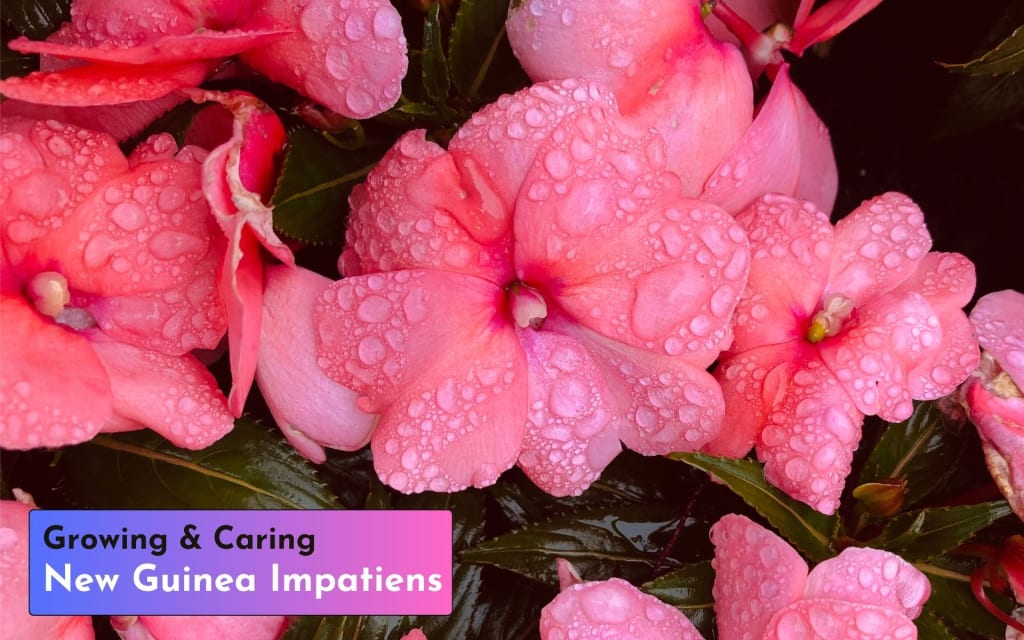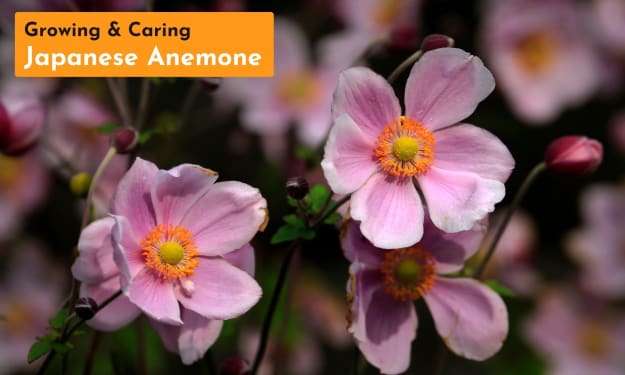New Guinea Impatiens: A Complete Guide to Growing and Caring
Impatiens hawkeri

New Guinea Impatiens (Impatiens hawkeri) are a popular flowering plant species that belong to the Balsaminaceae family. New Guinea Impatiens are native to Papua New Guinea and the Solomon Islands. These plants are commonly cultivated as ornamental bedding and are well-loved for their vibrant and showy flowers.
New Guinea Impatiens produce large, colorful flowers in various shades of pink, red, orange, lavender, and white. The flowers are typically larger and more vibrant than their relative, the common impatiens. The foliage of this plant is attractive and comes in various shades of green, often with hints of bronze or red.
Choosing the Right Location
The perfect location for New Guinea Impatiens is crucial to their health and flowering performance. These plants prefer specific light conditions and temperature ranges to thrive. Here are some additional factors to consider when choosing the right location for your New Guinea Impatiens:
Light Requirements: New Guinea Impatiens thrive in partial shade to filtered sunlight. In their native habitat, they are naturally found under the canopy of trees, where they receive dappled sunlight throughout the day. When planting in your garden, choose a location that receives morning sun and afternoon shade. Avoid areas with intense, direct sunlight, especially during the hot afternoon hours, as this can cause their delicate leaves to scorch.
Also Read: Guide to Growing Hellebore Flowers
If you're growing New Guinea Impatiens in containers, consider placing them on a porch or patio with a shade structure to protect them from the sun's full force. Hanging baskets or window boxes on the north or east side of your house can also provide the ideal light conditions.
Temperature Tolerance: New Guinea Impatiens are generally more tolerant of mild heat than traditional impatiens. However, they are still sensitive to extreme temperatures. If you live in an area with scorching summers, consider providing them with additional afternoon shade or dappled sunlight to protect them from the heat.
On the other hand, New Guinea Impatiens can struggle in colder temperatures. Avoid planting them too early in the spring when frost is still a concern. Wait until all danger of frost has passed before moving them outdoors or transplanting them into the garden.
Wind Protection: Choose a location that provides some protection from strong winds. While New Guinea Impatiens are relatively sturdy, they can be vulnerable to strong gusts, especially in exposed or windy areas. Wind can damage their delicate foliage and flowers or cause the plants to become lopsided. Planting them near a wall, fence, or taller plants can provide shelter from the wind.
Soil Considerations: While New Guinea Impatiens are not extremely picky about soil type, they prefer well-draining, fertile soil. Avoid heavy clay soils that retain water for extended periods, as this can lead to root rot. If your garden has clay soil, consider amending it with compost or well-rotted organic matter to improve drainage and nutrient content.
Microclimates: Be aware of microclimates in your garden, which are small areas with slightly different growing conditions than the surrounding environment. These microclimates can be caused by proximity to buildings, large rocks, or bodies of water. Some microclimates may offer more protection from the sun, wind, or frost, making them suitable spots for New Guinea Impatiens.
Planting New Guinea Impatiens
Planting New Guinea Impatiens properly ensures their successful establishment and growth. Whether you're starting from seeds or using young nursery plants, following these tips will help you create a beautiful and flourishing display of New Guinea Impatiens in your garden:
Timing
If you're growing New Guinea Impatiens from seeds, start them indoors about 8-10 weeks before your region's last expected frost date. This early indoor start allows the seedlings to develop and grow strong before being transplanted outdoors. Use a high-quality seed-starting mix and provide the proper moisture and warmth for germination.
For those using nursery-grown plants, wait until the danger of frost has passed before transplanting them into the garden. Cold temperatures can damage or kill tender young plants, so avoiding planting them too early is crucial.
Spacing
When planting New Guinea Impatiens in the garden, space them properly to ensure good air circulation and prevent overcrowding as they grow. The ideal spacing between plants is about 8 to 12 inches, depending on the specific variety's mature size. Some larger varieties may require more space to accommodate their growth.
Be mindful of the container's size and the number of plants you're planting in containers or hanging baskets. Overcrowding can lead to competition for nutrients and space, which may result in smaller, less vigorous plants.
Planting Depth
When transplanting New Guinea Impatiens into the garden, plant them at the same depth they were in their nursery pots. Avoid planting them too deep, as this can cause stem rot, and planting them too shallowly can leave the roots exposed and vulnerable to drying out.
Read Also: Growing and Maintaining Hydrangea Plants
Watering After Planting
After planting, thoroughly water the New Guinea Impatiens to settle the soil around the roots and help reduce transplant shock. Keep a close eye on the moisture levels in the following days, as newly transplanted seedlings or plants may require more frequent watering until they establish their root systems.
Container Planting
When planting New Guinea Impatiens in containers, use a high-quality, well-draining potting mix. Containers should have drainage holes to prevent waterlogged soil, which can lead to root rot. Consider mixing a slow-release granular fertilizer into the potting mix before planting to provide a steady supply of nutrients throughout the growing season.
You can create stunning displays for larger containers or hanging baskets by combining different colors and varieties of New Guinea Impatiens. This creates a visually appealing and dynamic arrangement that brightens any outdoor space.
Consider Companion Plants
New Guinea Impatiens can be excellent companion plants in mixed garden beds or containers. Consider pairing them with other shade-loving plants like ferns, hostas, or begonias. The contrasting foliage and complementary colors can create a striking and harmonious combination.
New Guinea Impatiens Care
New Guinea Impatiens are relatively low-maintenance plants that require regular care to ensure their health and continuous flowering. Following these care guidelines will help you keep your New Guinea Impatiens thriving and looking their best:
Watering
Consistent and appropriate watering is crucial for New Guinea Impatiens. Keep the soil consistently moist but not soggy. The best way to determine when to water is by checking the top inch of soil; if it feels dry to the touch, it's time to water. During hot summer days or in containers, you may need to water more frequently to prevent wilting. Avoid letting the soil dry out completely, as this can lead to stress and reduced flowering.
Fertilizing
Feed your New Guinea Impatiens with a balanced liquid fertilizer every 2-3 weeks during the growing season to encourage vigorous growth and continuous blooming. Follow the manufacturer's instructions for application rates to avoid over-fertilizing. Too much fertilizer can lead to excessive foliage growth at the expense of flowers. Alternatively, you can use a slow-release granular fertilizer at the beginning of the season to provide a steady supply of nutrients.
Deadheading and Pruning
Deadheading, or removing faded flowers, is essential to promote continuous blooming. Removing spent blooms redirects the plant's energy towards producing new buds instead of setting seeds. Regular deadheading will encourage your New Guinea Impatiens to produce more flowers throughout the season.
Additionally, occasional pruning helps maintain a compact and bushy shape. If you notice leggy growth or straggly branches, use clean, sharp pruners to trim them back. Avoid cutting too much at once, as this may stress the plant.
Mulching
Apply a layer of organic mulch around the base of your New Guinea Impatiens to conserve moisture, suppress weed growth, and regulate soil temperature. Mulching helps the soil retain moisture and reduces the need for frequent watering. Be sure not to pile the mulch directly against the plant's stem to prevent rot.
Pest and Disease Management
While New Guinea Impatiens are relatively resistant to pests, watching for any signs of infestations is essential. Common pests targeting these plants include aphids, spider mites, and whiteflies. Treat your plants with appropriate insecticidal soaps or natural remedies if you notice any pest activity.
Regarding diseases, the most significant concern is downy mildew. Choosing disease-resistant varieties and providing adequate air circulation can help prevent this issue. If you notice signs of downy mildew, such as yellowing leaves with a white, powdery growth on the undersides, remove and dispose of affected leaves to prevent further spread.
Winter Care
New Guinea Impatiens are typically grown as annuals in regions with cold winters. Before the first frost, you can collect seeds from your plants to save for the next growing season. In colder climates, you may need to replant new seedlings each year. You can attempt to overwinter your New Guinea Impatiens indoors in milder regions. Carefully dig up the plants, pot them in containers, and place them in a bright, cool location indoors. Reduce watering during winter dormancy and resume regular care in spring when the weather warms up.
Conclusion
With their vibrant colors and easy care, New Guinea Impatiens are a delightful choice for adding beauty to your garden or containers. So, fellow gardeners, let us continue our journey with a newfound appreciation for the art of cultivation, knowing that with each step, we create a symphony of color, a testament to the beauty of life's interconnectedness.
May the blooms of New Guinea Impatiens be a joyful reminder that the potential for endless wonder lies within the soil, awaiting only our hands to bring it to life. Happy gardening, and may your gardens forever blossom with the magic of nature's touch.
👉 Do you have any additional insights or questions? We highly value your feedback. Please share your thoughts by leaving a comment below.
About the Creator
Amir Hossain
I blog on everything and anything— hoping my blogs will make your days a bit happier!






Comments
There are no comments for this story
Be the first to respond and start the conversation.